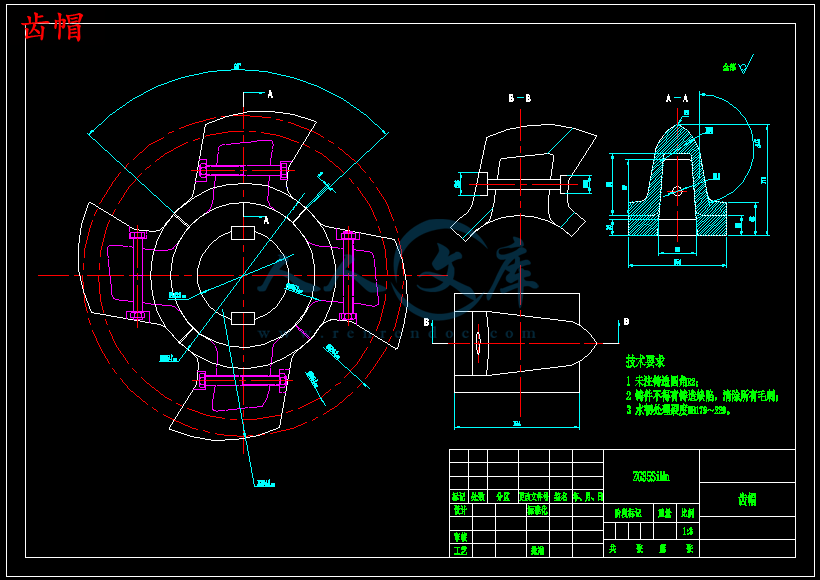【温馨提示】 购买原稿文件请充值后自助下载。
以下预览截图到的都有源文件,图纸是CAD,文档是WORD,下载后即可获得。
预览截图请勿抄袭,原稿文件完整清晰,无水印,可编辑。
有疑问可以咨询QQ:414951605或1304139763
摘要
煤泥是由细微粒煤,粉化骨石和水组成的粘稠物,具有粒度细,微粒含量多,水分和灰分含量大,热量低,粘结性较强,内聚力大的特点。
本文主要是根据煤泥破碎时出现的粘性大,容易造成机器堵塞等问题设计一台煤泥破碎机。在文中详细讲解了一下破碎煤泥存在的问题,分析每一种破碎机构破碎煤泥会出现的问题,经过分析选择辊式破碎机构。结合设计参数,破碎机效率:50t/h,每天工作8小时,一年工作300天,设计一台齿辊破碎机。本文对工作参数进行了确定,然后进行了带传动,减速器齿轮,传动齿轮和齿辊轴的设计与校核,设计过程中验算了设计的参数,均合理。设计的破碎机中由一台电动机带动皮带,经过液力偶合器传递到减速器,减速器带动辊轴的转动来实现煤泥的破碎。由于齿辊轴是主要破碎机构,对其进行了校核。在破碎过程中会产生振动,我们选择了在大带轮和减速器之间加入了液力偶合器。然后对轴承进行了选择和校核。最后确定了减速器箱体的结构和箱体的基本尺寸。
关键词:煤泥 ;齿辊轴;破碎机
Abstract
Slime is by fine coal particles, powder bone stone and water viscous material, with fine particle size, particle content, moisture and ash content are low in calories, strong adhesion, cohesion characteristics.
The main purpose of this paper is according to viscous slime crushing of large, easily lead to jam the machine design of a coal crusher. In this paper explain in detail the a broken slime existing problems, analysis each kind of crushing mechanism slime crushing, through analysis and selection of roller crusher mechanism. Combined with design parameters, crusher efficiency: 50t/h, 8 hours a day, a year working 300 days, design a tooth roller crusher. The the working parameters were determined. The followed by a belt drive, gear reducer, transmission gear and the gear and shaft design and verification and design in the process of checking the design parameters are reasonable. Design of crusher is composed of a motor drive belt, after hydraulic coupling transfer to reducer, reducer so as to drive the roll axis of rotation to achieve slime crushing. Since the roller shaft is the main crushing mechanism, it is checked.. In the crushing process will produce vibration, we choose the large pulley and reducer between joined hydraulic coupler. Then the bearing is selected and checked.. Finally, the structure of the reducer box and the basic size of the box are determined.
Keywords: coal ; roll shaft ; crusher
目录
1 绪论 1
2 破碎机的发展历史 2
3 煤泥破碎机总体设计方案 3
3. 1 破碎的主要形式 3
3. 2 破碎煤泥过程中存在的问题 3
3.2.1 煤泥的特点 3
3.2.2 破碎煤泥存在的问题 4
3. 3 破碎机构形式选择 4
3. 4 破碎机的工作原理 10
4 煤泥破碎机参数的确定 12
4. 1 总体结构与布局的设计 12
4. 2 电动机功率 13
4. 3 破碎机基本参数的估算 14
4. 4 工作参数的确定 15
4.4.1 辊子中心距 15
4.4.2 传动装置的运动和动力参数 17
4. 5 带传动的设计计算 19
4. 6 减速器齿轮设计 22
4. 7 齿辊间传动齿轮的设计 27
4. 8 轴的设计与校核 32
4.8.1 减速器高速轴设计 32
4.8.2 破碎辊(1)轴的设计 35
4.8.3 破碎辊(2)轴的设计 40
4. 9 键的选择与校核 44
4. 10 轴承的选择 45
4.10.1 确定轴承型号 45
4.10.2 轴承的校核 45
4.11齿环和齿帽的设计 50
4.11.1齿帽的设计 50
4.11.2齿环的设计 51
5 液力偶合器的选择 52
5. 1 液力偶合器的特点 52
5.2 液力偶合器的结构和原理 52
6. 润滑与密封 56
6. 1 减速器的箱体结构 56
6. 2 箱体的基本尺寸 56
结论 58
致谢 59
参考文献 60
附录 61
翻译部分 63
中文译文 63
英文原文 69
1 绪论
煤泥泛指煤粉含水形成的半固体物,是煤炭生产过程中的一种产品,根据品种的不同和形成机理的不同,其性质差别非常大,可利用性也有较大差别,大致有如下几种类型:
(1) 炼焦煤选煤厂的浮选尾煤: 这类煤泥在国外,一般是一种废弃物,其性质与洗选矸石或中煤类似。因煤质不同,浮选煤泥的品质有较大差别,如淮南的气煤,浮选工艺的抽出率只有30%





 川公网安备: 51019002004831号
川公网安备: 51019002004831号